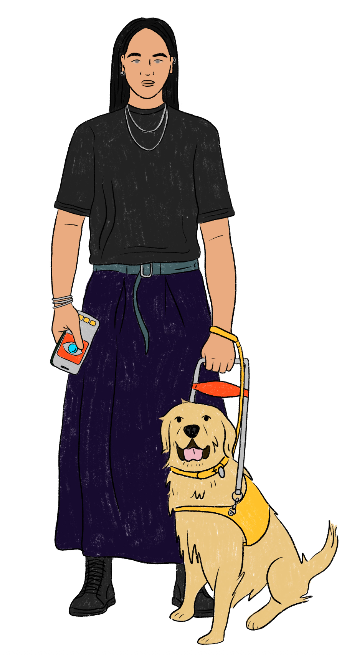Meet Vinh, who has vision loss. Learn about Vinh’s accessibility requirements to better understand how to support students who have similar conditions.
Vinh is a 20-year-old student who uses they/them pronouns. Their life motto is “Be your own boss”.
Vinh has progressive vision loss, which began as low vision and has progressed to blindness. Their goals are to feel at home on campus and capable of navigating the physical and online spaces, make friends at university and find a job after graduating.
Here are some of the things that Vinh needs for an accessible learning experience:
- Vinh’s accessibility requirements change with the severity of their vision loss – during their studies, their condition progresses to blindness, which means they need to rely more on assistive technology. They also begin working with an assistance animal – a Labrador named Toby.
- Screenreader-accessible digital content is crucial for Vinh, including high colour contrast, large sans serif fonts, alternative text, bulleted and numbered lists, following heading hierarchies (i.e. H1, H2, H3), and descriptive links.
- Tactile models (e.g. Swell paper and medical models) can replace interactive, visual materials. The Inclusive Practices team in the Education Portfolio can help with this.
- May be accompanied by an Accessibility Assistant.
Here are some of the barriers that Vinh deals with in daily life.
- Missing out on information and being unaware that they’ve missed out.
- Poorly formatted documents that are inaccessible for their assistive technology, or overall lack of compatibility with their magnifiers and screen readers.
- Descriptions of visual content like images or videos may not be provided by their teachers.
Online
- Many important systems needed for studying or administration are not accessible.
- There is a lot of cognitive overload in online classes. When relying on the screen reader Vinh has their screen reader in one ear, the class in the other, both sometimes speaking at the same time, so there’s a lot of auditory overwhelm. On top of that there’s the need to navigate and try to type what they want to say in the chat box. Vinh knows they miss a lot of the conversations in the chat.
- Having the camera on in online classes can cause anxiety, as they are very conscious that everyone else can see them, but they cannot see the other students or themselves. They are not sure whether the camera has the right angle, whether they are making an expression that they should not, whether they are sharing the right thing on the screen.
On campus
- Vinh needs consistency to navigate their way around campus. It can be frustrating when escalators, lifts or toilets are out of order and they need to find a different option. It can cause cognitive overload to navigate around campus – unexpected challenges like crowds or fire drills can cause additional issues.
- Finding a seat can cause a lot of fear for Vinh as they worry about sitting too close to, or even on top of someone else. For group work, they appreciate if the group can move to where they are already sitting so that they do not have to get up and navigate to somewhere else. It’s helpful when academics can assist in managing these situations in a respectful and dignified way.
- Signage is not always accessible on campus, and can take a lot of extra cognitive load to navigate. For example, when Vinh is seeking out an academic the office doors have accessible room numbers in braille but the names on the door don’t, so Vinh has to remember 6 digits to navigate to someone’s office to know they’re in the right place.
- Lifts aren’t always accessible, e.g. the touch screens or hearing which lift doors are opening.
- Stairs can be uneven.
- Finding rooms on campus can be problematic, especially if rooms change with short notice.
The following resources provide more information about vision loss.
These resources show how you can support students like Vinh.
Please note
- Everyone’s access needs are different, and what works for one person may not work for another.
- Other health conditions can make access needs more complex or change how they show up day to day.
- Some people may have other disabilities they don’t mention if they aren’t relevant, but these may still affect them at times.
